Retro. Modern. Iconic. That’s The Worm.
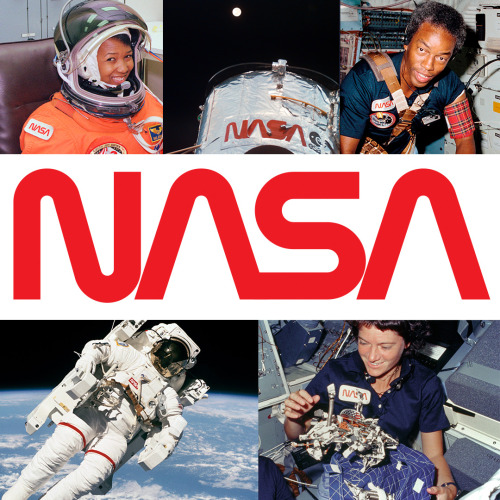
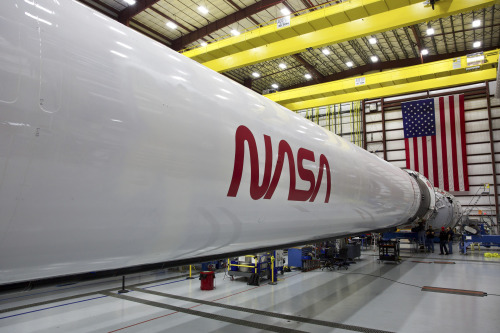
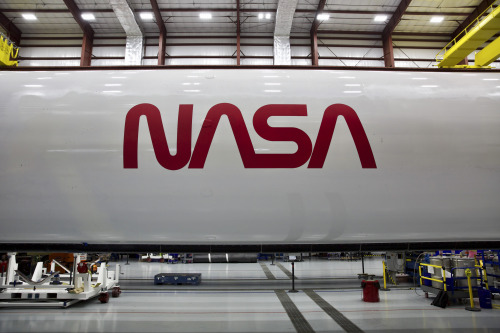
Retro. Modern. Iconic. That’s the worm.
#TheWormIsBack
Our beloved symbol of exploration will fly once again, just in time to mark the return of human spaceflight on American rockets from American soil. The retired logo is making its comeback on on SpaceX’s Falcon 9 rocket that will take flight later this year when we #LaunchAmerica once again.
The NASA insignia, or "meatball," seen in our profile image, was quite difficult to reproduce with 1970s technology. In 1975, enter the sleek, simple design you see above! The world knew it as “the worm.” For a period of time we were able to thrive with both the worm and the meatball. However, in 1992, the 1970s brand was retired - except on clothing and other souvenir items - in favor of the original late 1950s graphic.
Image Credit: NASA/SpaceX
Make sure to follow us on Tumblr for your regular dose of space: http://nasa.tumblr.com.
More Posts from Nasa and Others
Is it safe to look at the eclipse if it isn't fully covered by the sun? Say 75%
Not without proper eye wear. There will still be too much light that could burn your eyes. But you can have a ton of fun viewing the Sun using a https://eclipse.aas.org/eye-safety/projection. In fact, there is a sunspot that is now on the Sun that you should be able to see using this indirect method!
All-Star Moments in Space Communications and Navigation
How do we get information from missions exploring the cosmos back to humans on Earth? Our space communications and navigation networks – the Near Space Network and the Deep Space Network – bring back science and exploration data daily.
Here are a few of our favorite moments from 2024.

1. Hip-Hop to Deep Space
The stars above and on Earth aligned as lyrics from the song “The Rain (Supa Dupa Fly)” by hip-hop artist Missy Elliott were beamed to Venus via NASA’s Deep Space Network. Using a 34-meter (112-foot) wide Deep Space Station 13 (DSS-13) radio dish antenna, located at the network’s Goldstone Deep Space Communications Complex in California, the song was sent at 10:05 a.m. PDT on Friday, July 12 and traveled about 158 million miles from Earth to Venus — the artist’s favorite planet. Coincidentally, the DSS-13 that sent the transmission is also nicknamed Venus!

NASA's PACE mission transmitting data to Earth through NASA's Near Space Network.
2. Lemme Upgrade You
Our Near Space Network, which supports communications for space-based missions within 1.2 million miles of Earth, is constantly enhancing its capabilities to support science and exploration missions. Last year, the network implemented DTN (Delay/Disruption Tolerant Networking), which provides robust protection of data traveling from extreme distances. NASA’s PACE (Plankton, Aerosol, Cloud, ocean Ecosystem) mission is the first operational science mission to leverage the network’s DTN capabilities. Since PACE’s launch, over 17 million bundles of data have been transmitted by the satellite and received by the network’s ground station.

A collage of the pet photos sent over laser links from Earth to LCRD and finally to ILLUMA-T (Integrated LCRD Low Earth Orbit User Modem and Amplifier Terminal) on the International Space Station. Animals submitted include cats, dogs, birds, chickens, cows, snakes, and pigs.
3. Who Doesn’t Love Pets?
Last year, we transmitted hundreds of pet photos and videos to the International Space Station, showcasing how laser communications can send more data at once than traditional methods. Imagery of cherished pets gathered from NASA astronauts and agency employees flowed from the mission ops center to the optical ground stations and then to the in-space Laser Communications Relay Demonstration (LCRD), which relayed the signal to a payload on the space station. This activity demonstrated how laser communications and high-rate DTN can benefit human spaceflight missions.

4K video footage was routed from the PC-12 aircraft to an optical ground station in Cleveland. From there, it was sent over an Earth-based network to NASA’s White Sands Test Facility in Las Cruces, New Mexico. The signals were then sent to NASA’s Laser Communications Relay Demonstration spacecraft and relayed to the ILLUMA-T payload on the International Space Station.
4. Now Streaming
A team of engineers transmitted 4K video footage from an aircraft to the International Space Station and back using laser communication signals. Historically, we have relied on radio waves to send information to and from space. Laser communications use infrared light to transmit 10 to 100 times more data than radio frequency systems. The flight tests were part of an agency initiative to stream high-bandwidth video and other data from deep space, enabling future human missions beyond low-Earth orbit.

The Near Space Network provides missions within 1.2 million miles of Earth with communications and navigation services.
5. New Year, New Relationships
At the very end of 2024, the Near Space Network announced multiple contract awards to enhance the network’s services portfolio. The network, which uses a blend of government and commercial assets to get data to and from spacecraft, will be able to support more missions observing our Earth and exploring the cosmos. These commercial assets, alongside the existing network, will also play a critical role in our Artemis campaign, which calls for long-term exploration of the Moon.

On Monday, Oct. 14, 2024, at 12:06 p.m. EDT, a SpaceX Falcon Heavy rocket carrying NASA’s Europa Clipper spacecraft lifts off from Launch Complex 39A at NASA’s Kennedy Space Center in Florida.
6. 3, 2, 1, Blast Off!
Together, the Near Space Network and the Deep Space Network supported the launch of Europa Clipper. The Near Space Network provided communications and navigation services to SpaceX’s Falcon Heavy rocket, which launched this Jupiter-bound mission into space! After vehicle separation, the Deep Space Network acquired Europa Clipper’s signal and began full mission support. This is another example of how these networks work together seamlessly to ensure critical mission success.

Engineer Adam Gannon works on the development of Cognitive Engine-1 in the Cognitive Communications Lab at NASA’s Glenn Research Center.
7. Make Way for Next-Gen Tech
Our Technology Education Satellite program organizes collaborative missions that pair university students with researchers to evaluate how new technologies work on small satellites, also known as CubeSats. In 2024, cognitive communications technology, designed to enable autonomous space communications systems, was successfully tested in space on the Technology Educational Satellite 11 mission. Autonomous systems use technology reactive to their environment to implement updates during a spaceflight mission without needing human interaction post-launch.

A first: All six radio frequency antennas at the Madrid Deep Space Communication Complex, part of NASA’s Deep Space Network (DSN), carried out a test to receive data from the agency’s Voyager 1 spacecraft at the same time.
8. Six Are Better Than One
On April 20, 2024, all six radio frequency antennas at the Madrid Deep Space Communication Complex, part of our Deep Space Network, carried out a test to receive data from the agency’s Voyager 1 spacecraft at the same time. Combining the antennas’ receiving power, or arraying, lets the network collect the very faint signals from faraway spacecraft.
Here’s to another year connecting Earth and space.
Make sure to follow us on Tumblr for your regular dose of space!
Happy International Women’s Day!

Today we celebrate International Women’s Day, a day in which we honor and recognize the contributions of women…both on Earth and in space.

Since the beginning, women have been essential to the progression and success of America’s space program.

Throughout history, women have had to overcome struggles in the workplace. The victories for gender rights were not achieved easily or quickly, and our work is not done.

Today, we strive to make sure that our legacy of inclusion and excellence lives on.

We have a long-standing cultural commitment to excellence that is largely driven by data, including data about our people. And our data shows progress is driven by questioning our assumptions and cultural prejudices – by embracing and nurturing all talent we have available, regardless of gender, race or other protected status, to build a workforce as diverse as our mission. This is how we, as a nation, will take the next giant leap in exploration.

As a world leader in science, aeronautics, space exploration and technology, we have a diverse mission that demands talent from every corner of America, and every walk of life.

So, join us today, and every day, as we continue our legacy of inclusion and excellence.

Happy International Women’s Day!
Learn more about the inspiring woman at NASA here: https://women.nasa.gov/
What Did Astronaut Scott Kelly Do After a #YearInSpace?
Astronaut Scott Kelly just returned from his One-Year Mission aboard the International Space Station. After spending 340 days on orbit, you can imagine that he started to miss a few Earthly activities. Here are a few things he did after his return home:
Watched a Sunset

While on the International Space Station for his One-Year Mission, astronaut Scott Kelly saw 16 sunrises/sunsets each day...so he definitely didn’t miss out on the beauty. That said, watching a sunset while on Earth is something that he had to wait to see. Tweet available HERE.
Ate Fresh Food

After spending a year on the International Space Station, eating precooked food, anyone would be excited to dig into a REAL salad. Astronaut Scott Kelly was no exception, and posted about his first salad on Earth after his one-year mission. Learn more about what astronauts eat while in space HERE. Tweet available HERE.
Jumped into a Pool

Water is a precious resource in space. Unfortunately, that means that there isn’t a pool on the space station. Luckily, astronaut Scott Kelly was able to jump into some water after his return to Earth. Tweet/video available HERE.
Sat at a Dinner Table

While living on the International Space Station, crew members regularly enjoy their meals together, but do so while floating in microgravity. The comfort of pulling up a chair to the dinner table is something they can only experience once they’re back home on Earth. Tweet available HERE.
Enjoyed the Weather

When crew members live on the space station they can’t just step outside for a stroll. The only time they go outside the orbiting laboratory is during a spacewalk. Even then, they are confined inside a bulky spacesuit. Experiencing the cool breeze or drops of rain are Earthly luxuries. Tweet available HERE.
Stopped by the Doctor’s Office

The One-Year Mission doesn’t stop now that astronaut Scott Kelly is back on Earth. Follow-up exams and tests will help scientists understand the impacts of microgravity on the human body during long-duration spaceflight. This research will help us on our journey to Mars. Tweet available HERE.
Visited the Denist

When you spend a year in space, you’ll probably need to catch up on certain things when you return to Earth. Astronaut Scott Kelly made sure to include a visit to the dentist on his “return home checklist”. Tweet available HERE.
Make sure to follow us on Tumblr for your regular dose of space: http://nasa.tumblr.com
Astronaut out! Thank you for all the amazing questions.
Make sure to follow us on Tumblr for your regular dose of space: http://nasa.tumblr.com


“I realized, really for the first time, that people who didn’t even know me were wishing for my success — hoping to share in the pride of future accomplishments, but even more important, willing to provide encouragement in the face of disappointments. I hope that by sharing my experiences, others will be inspired to set high goals for themselves.”
- Ellen Ochoa is the first Hispanic director of NASA’s Johnson Space Center and the first Hispanic woman to go to space.
Q: You were the first Hispanic woman to go to space, and you’re the first Hispanic director of the Johnson Space Center. What does the achievement of firsts like these mean to you? What kind of responsibility comes with paving the way?
Becoming an astronaut was a personal goal for me, so I was surprised and overwhelmed to receive such warm support from the entire Hispanic community when I was selected for the astronaut corps. I realized, really for the first time, that people who didn’t even know me were wishing for my success — hoping to share in the pride of future accomplishments, but even more important, willing to provide encouragement in the face of disappointments. In the same way, in addition to working hard to do my best at every position I’ve had, it became an important part of my job to provide encouragement to others, particularly women and minorities underrepresented in STEM [Science Technology Engineering and Math] fields. I hope that by sharing my experiences, others will be inspired to set high goals for themselves.
Q: Have you experienced any particular challenges as a female astronaut? How have you stayed motivated in the face of such challenges?
Actually, the women astronauts who came before me performed their jobs so well that it really wasn’t an issue. There was probably more skepticism due to my research background, given that the job is an operational one, and I didn’t have much experience in that environment. The training we’re provided helped prepare me well, as did veterans astronauts who passed on helpful tips.
Q: As a pioneer of spacecraft technology and a champion of outreach, how do you think we can inspire more women to enter STEM fields?
Use every available communications avenue to let women know about the interesting and rewarding careers in the STEM fields. The website Women@NASA profiles many women around the agency, having them describe in their own words what they do and the path that led them to their careers. And since girls start making choices in middle school that can limit their options later on, there’s a section on the website aimed specifically at middle school girls called Aspire to Inspire featuring women at Johnson Space Center. NASA has also made great use of many social media platforms to spread the word on what we are doing in space exploration, both human and robotics. From the first flyby of Pluto to the completion of a one-year mission onboard the International Space Station, this has been an exciting year for NASA.
Around the World 100,000 Times
The International Space Station is a microgravity laboratory in which an international crew of six people live and work while traveling at a speed of five miles per second (or 17,500 miles per hour), orbiting Earth every 90 minutes.
Monday, May 16, marks the International Space Station’s 100,000th orbit!
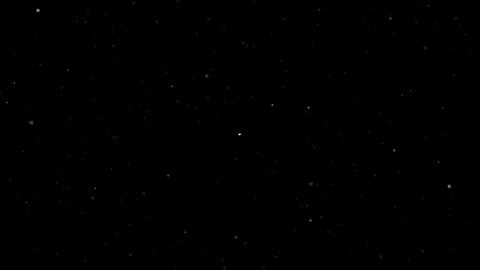
That’s more than 2,643,342,240 miles traveled! Which is also like 10 round trips to Mars, OR nearly the distance to Neptune!
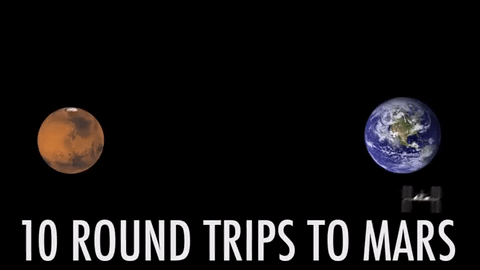
The space station has been in orbit for over 17 years, and during that time, over 1,922 research investigations have been performed. More than 1,200 scientific results publications have been produced as a result.
Important studies like the VEGGIE experiment, which is working to grow plants in microgravity, and the Twin’s Study, which is studying the impacts of microgravity on the human body, are helping us on our journey to Mars. Using this unique orbiting laboratory as a place to conduct research is helping us learn important things for future deep space missions.
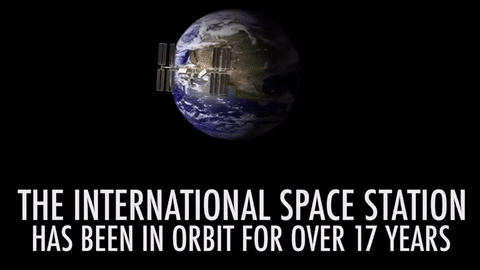
There have even been 222 different people that have visited the space station. This includes the current crew that is working and living on orbit.
Did you know that the space station is the third brightest object in the sky? If you know when and where to look up, you can spot it on your own! Find out when and where to look up HERE.
On Snapchat? Watch today’s Live Story to discover more about the orbiting laboratory and get a tour of the station! You can also add ‘nasa’ on Snapchat to get a regular dose of space.
Make sure to follow us on Tumblr for your regular dose of space: http://nasa.tumblr.com
13 Reasons to Have an Out of This World Friday (the 13th)
1. Know that not all of humanity is bound to the ground

Since 2000, the International Space Station has been continuously occupied by humans. There, crew members live and work while conducting important research that benefits life on Earth and will even help us eventually travel to deep space destinations, like Mars.
2. Smart people are up all night working in control rooms all over NASA to ensure that data keeps flowing from our satellites and spacecraft

Our satellites and spacecraft help scientists study Earth and space. Missions looking toward Earth provide information about clouds, oceans, land and ice. They also measure gases in the atmosphere, such as ozone and carbon dioxide, and the amount of energy that Earth absorbs and emits. And satellites monitor wildfires, volcanoes and their smoke.

Satellites and spacecraft that face toward space have a variety of jobs. Some watch for dangerous rays coming from the sun. Others explore asteroids and comets, the history of stars, and the origin of planets. Some fly near or orbit other planets. These spacecraft may look for evidence of water on Mars or capture close-up pictures of Saturn’s rings.
3. The spacecraft, rockets and systems developed to send astronauts to low-Earth orbit as part of our Commercial Crew Program is also helping us get to Mars
Changes to the human body during long-duration spaceflight are significant challenges to solve ahead of a mission to Mars and back. The space station allows us to perform long duration missions without leaving Earth’s orbit.

Although they are orbiting Earth, space station astronauts spend months at a time in near-zero gravity, which allows scientists to study several physiological changes and test potential solutions. The more time they spend in space, the more helpful the station crew members can be to those on Earth assembling the plans to go to Mars.
4. Two new science missions will travel where no spacecraft has gone before…a Jupiter Trojan asteroid and a giant metal asteroid!

We’ve selected two missions that have the potential to open new windows on one of the earliest eras in the history of our solar system – a time less than 10 million years after the birth of our sun!

The first mission, Lucy, will visit six of Jupiter’s mysterious Trojan asteroids. The Trojans are thought to be relics of a much earlier era in the history of the solar system, and may have formed far beyond Jupiter’s current orbit.

The second mission, Psyche, will study a unique metal asteroid that’s never been visited before. This giant metal asteroid, known as 16 Psyche, is about three times farther away from the sun than is the Earth. Scientists wonder whether Psyche could be an exposed core of an early planet that could have been as large as Mars, but which lost its rocky outer layers due to a number of violent collisions billions of years ago.
5. Even astronauts eat their VEGGIES’s
NASA astronaut Shane Kimbrough collected the third and final harvest of the latest round of the Veggie investigation, testing the capability to grow fresh vegetables on the International Space Station.

Understanding how plants respond to microgravity is an important step for future long-duration space missions, which will require crew members to grow their own food. Crew members have previously grown lettuce and flowers in the Veggie facility. This new series of the study expands on previous validation tests.
6. When you feel far away from home, you can think of the New Horizons spacecraft as it heads toward the Kuiper Belt, and the twin Voyager spacecraft are beyond the influence of our sun…billions of miles away

Our New Horizons spacecraft completed its Pluto flyby in July 2015 and has continued on its way toward the Kuiper Belt. The spacecraft continues to send back important data as it travels toward deeper space at more than 32,000 miles per hour, and is nearly 3.2 billion miles from Earth.

In addition to New Horizons, our twin Voyager 1 and 2 spacecraft are exploring where nothing from Earth has flown before. Continuing on their more-than-37-year journey since their 1977 launches, they are each much farther away from Earth and the sun than Pluto. In August 2012, Voyager 1 made the historic entry into interstellar space, the region between the stars, filled with material ejected by the death of nearby stars millions of years ago.
7. Earth has a magnetic field that largely protects it from the solar wind stripping away out atmosphere…unlike Mars

Findings from our MAVEN mission have identified the process that appears to have played a key role in the transition of the Martian climate from an early, warm and wet environment to the cold, arid planet Mars is today. MAVEN data have enabled researchers to determine the rate at which the Martian atmosphere currently is losing gas to space via stripping by the solar wind. Luckily, Earth has a magnetic field that largely protects it from this process.
8. There are humans brave enough to not only travel in space, but venture outside the space station to perform important repairs and updates during spacewalks

Spacewalks are important events where crew members repair, maintain and upgrade parts of the International Space Station. These activities can also be referred to as EVAs – Extravehicular Activities. Not only do spacewalks require an enormous amount of work to prepare for, but they are physically demanding on the astronauts. They are working in the vacuum of space in only their spacewalking suit.

When on a spacewalk, astronauts use safety tethers to stay close to their spacecraft. One end of the tether is hooked to the spacewalker, while the other end is connected to the vehicle. Spacewalks typically last around 6.5 hours, but can be extended to 7 or 8 hours, if necessary.
9. We’re working to create new aircraft that will dramatically reduce fuel use, emissions and noise…meaning we could change the way you fly!

The nation’s airlines could realize more than $250 billion dollars in savings in the near future thanks to green-related technologies that we are developing and refining. These new technologies could cut airline fuel use in half, pollution by 75% and noise to nearly one-eighth of today’s levels!
10. You can see a global image of your home planet…EVERY DAY

Once a day, we will post at least a dozen new color images of Earth acquired from 12 to 36 hours earlier. These images are taken by our EPIC camera from one million miles away on the Deep Space Climate Observatory (DSCOVR). Take a look HERE.
11. Employees of NASA have always been a mission driven bunch, who try to find answers that were previously unknown
The film “Hidden Figures,” focuses on the stories of Katherine Johnson, Mary Jackson and Dorothy Vaughan, African-American women who were essential to the success of early spaceflight.
Today, we embrace their legacy and strive to include everyone who wants to participate in our ongoing exploration. In the 1960’s, we were on an ambitious journey to the moon, and the human computers portrayed in Hidden Figures helped get us there. Today, we are on an even more ambitious journey to Mars. We are building a vibrant, innovative workforce that reflects a vast diversity of discipline and thought, embracing and nurturing all the talent we have available, regardless of gender, race or other protected status. Take a look at our Modern Figures HERE.
12. A lot of NASA-developed tech has been transferred for use to the public
Our Technology Transfer Program highlights technologies that were originally designed for our mission needs, but have since been introduced to the public market. HERE are a few spinoff technologies that you might not know about.
13. If all else fails, here’s an image of what we (Earth) and the moon look like from Mars

From the most powerful telescope orbiting Mars comes a new view of Earth and its moon, showing continent-size detail on the planet and the relative size of the moon. The image combines two separate exposures taken on Nov. 20 by our High Resolution Imaging Science Experiment (HiRISE) camera on our Mars Reconnaissance Orbiter.
In the image, the reddish feature near the middle of the face of Earth is Australia.
Thanksgiving...in Space
Since 2000, humans have continuously lived and worked on the International Space Station. That means plenty of crew members have celebrated holidays off the Earth.

Although they’re observing the same holidays, they do so in a slightly different way because of the unique environment 250 miles above the Earth.
Consider the differences of living on Earth and in space…

Food scientists must develop foods that will be easier to handle and consume in an environment without gravity. The food must not require refrigeration and also provide the nutrition humans need to remain healthy.

Freeze drying food allows it to remain stable at room temperature, while also significantly reducing its weight.

Did you know that all the food sent to the space station is precooked? Sending precooked food means that it requires no refrigeration and is either ready to eat or can be prepared by simply adding water or by heating.

The only exception are the fruit and vegetables stowed in the fresh food locker. The food comes in either freeze-dried containers or thermostabilized pouches. If freeze-dried in a vacuum sealed package, the astronauts have a rehydration system in-flight, which they use restore moisture in their food. If thermostabilized, the packaging is designed to preserve the food similar to canned products, but instead in a flexible, multi-layered pouch.
So what will the space station crew eat this year (2016) for Thanksgiving?
Turkey
Cherry/Blueberry Cobbler
Candied Yams
Rehydratable Cornbread Dressing
Rehydratable Green Beans and Mushrooms
Rehydratable Mashed Potatoes
What are you bringing to Thanksgiving on Earth this year? Treat your family and friends astronaut-style with this cornbread dressing recipe straight out of our Space Food Systems Laboratory…no freeze drying required!

For spaceflight preparation:
Baked dressing is transferred to metal tray and freeze-dried accordingly. One serving of cornbread dressing shall weigh approximately 145 g prior to freeze-drying and 50 g after freeze-drying.
Learn more about our Food Systems Laboratory in this Facebook Live video: https://www.facebook.com/ISS/videos/1359709837395277/
Happy Thanksgiving!
Make sure to follow us on Tumblr for your regular dose of space: http://nasa.tumblr.com
-
 garuda606 liked this · 1 year ago
garuda606 liked this · 1 year ago -
 descafeinadoo liked this · 2 years ago
descafeinadoo liked this · 2 years ago -
 noparticularfocus liked this · 3 years ago
noparticularfocus liked this · 3 years ago -
 futurewear reblogged this · 3 years ago
futurewear reblogged this · 3 years ago -
 midorides-ka liked this · 3 years ago
midorides-ka liked this · 3 years ago -
 26cyberworms liked this · 3 years ago
26cyberworms liked this · 3 years ago -
 onyadarling liked this · 3 years ago
onyadarling liked this · 3 years ago -
 elachupacabra liked this · 4 years ago
elachupacabra liked this · 4 years ago -
 starstruckcomicsanimeoperator liked this · 4 years ago
starstruckcomicsanimeoperator liked this · 4 years ago -
 steve51world liked this · 4 years ago
steve51world liked this · 4 years ago -
 puffydearlysmith liked this · 4 years ago
puffydearlysmith liked this · 4 years ago -
 usafphantom2 reblogged this · 4 years ago
usafphantom2 reblogged this · 4 years ago -
 usafphantom2 liked this · 4 years ago
usafphantom2 liked this · 4 years ago -
 sillykittypaws liked this · 4 years ago
sillykittypaws liked this · 4 years ago -
 silverenderfox liked this · 4 years ago
silverenderfox liked this · 4 years ago -
 renjunniesmoomin liked this · 4 years ago
renjunniesmoomin liked this · 4 years ago -
 sachidiva liked this · 4 years ago
sachidiva liked this · 4 years ago -
 cloudsandsubmarines liked this · 4 years ago
cloudsandsubmarines liked this · 4 years ago -
 im-gonna-be-late reblogged this · 4 years ago
im-gonna-be-late reblogged this · 4 years ago -
 im-gonna-be-late liked this · 4 years ago
im-gonna-be-late liked this · 4 years ago -
 chad8472 reblogged this · 4 years ago
chad8472 reblogged this · 4 years ago -
 gotlostbutneverfound liked this · 4 years ago
gotlostbutneverfound liked this · 4 years ago -
 crookedgladiatorlover reblogged this · 4 years ago
crookedgladiatorlover reblogged this · 4 years ago -
 crookedgladiatorlover liked this · 4 years ago
crookedgladiatorlover liked this · 4 years ago -
 maggietann reblogged this · 5 years ago
maggietann reblogged this · 5 years ago -
 maggietann liked this · 5 years ago
maggietann liked this · 5 years ago -
 likethatbitchh liked this · 5 years ago
likethatbitchh liked this · 5 years ago -
 innerfa18eww2tarawadean liked this · 5 years ago
innerfa18eww2tarawadean liked this · 5 years ago -
 witheredlittleflower liked this · 5 years ago
witheredlittleflower liked this · 5 years ago -
 intj-bitch liked this · 5 years ago
intj-bitch liked this · 5 years ago -
 super-blubb reblogged this · 5 years ago
super-blubb reblogged this · 5 years ago -
 waningstarlight reblogged this · 5 years ago
waningstarlight reblogged this · 5 years ago -
 dimwitdecember liked this · 5 years ago
dimwitdecember liked this · 5 years ago
Explore the universe and discover our home planet with the official NASA Tumblr account
1K posts